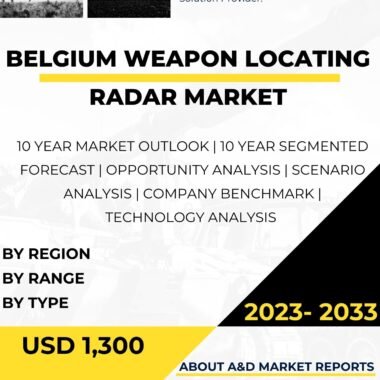Description
Weapon Locating Radar (WLR) plays a crucial role in modern military operations by providing essential information to detect and track incoming artillery shells, rockets, and mortar rounds. These radars enhance battlefield situational awareness, enabling military forces to respond rapidly and effectively to enemy threats. The United States has been a pioneer in the development and deployment of advanced Weapon Locating Radar systems, equipping its armed forces with cutting-edge technology to safeguard personnel and assets on the battlefield.
The primary function of Weapon Locating Radar is to detect and track incoming projectiles fired from enemy artillery, rocket launchers, or mortars. These radars employ sophisticated sensing technology to detect the trajectory and origin of hostile fire, thereby providing vital information to military forces. By accurately identifying the firing positions, troops can respond with timely and effective countermeasures.
WLR systems typically utilize radar technology, which uses radio waves to detect and track objects in the air. The radars operate on different frequencies, including X-band, S-band, and C-band, each offering advantages in terms of range, resolution, and weather resistance. Additionally, many WLR systems incorporate Doppler processing, which allows for the identification of moving objects (projectiles) amidst clutter, such as stationary buildings or terrain features.
Many Weapon Locating Radars in the United States use pulse-Doppler radar technology. Pulse-Doppler radars are adept at detecting and tracking fast-moving objects, such as projectiles, while filtering out stationary background clutter. This capability ensures accurate target identification, allowing military forces to focus on imminent threats and prioritize response actions.
Pulse-Doppler radar works by transmitting short pulses of radio waves and then listening for their echoes. The radar measures the frequency shift (Doppler shift) of the returning echoes caused by the moving projectiles. This information enables the radar to calculate the velocity and direction of the incoming threat, essential for predicting the impact point and determining the firing position.
Some advanced WLR systems in the United States utilize Phased Array Radar technology. Phased array radars consist of multiple antenna elements that can electronically steer the radar beam without the need for physically moving the antenna. This rapid beam steering allows for agile tracking of multiple targets simultaneously.
The ability to electronically steer the radar beam makes phased array radars highly versatile and resistant to jamming attempts. Furthermore, they offer improved accuracy and reliability, crucial factors in rapidly detecting and tracking incoming projectiles.
Weapon Locating Radar is primarily used for artillery and missile counterfire operations. When enemy artillery or rocket fire is detected, the radar quickly calculates the trajectory of the projectiles and determines the origin of the hostile fire. This information is relayed to military command centers and field units, enabling swift response actions to neutralize the threat.
By rapidly identifying the firing positions of enemy artillery, WLR systems allow friendly forces to take evasive actions, seek cover, or conduct counterfire operations to suppress and neutralize the threat. Additionally, the data provided by the WLR helps in adjusting friendly fire, minimizing collateral damage, and maximizing the efficiency of response efforts.
Furthermore, Weapon Locating Radar has applications in Air Defense and Force Protection. By detecting and tracking incoming artillery shells, rockets, and mortars, WLR systems enhance the protection of military installations, forward operating bases, and critical infrastructure from enemy attacks.
Another vital application of WLR systems is in providing intelligence for targeting enemy artillery and rocket positions. By analyzing the data from repeated firing instances, military intelligence can identify patterns and trends, leading to more effective targeting of enemy artillery and disrupting their ability to launch attacks.
Several major defense contractors and companies in the United States are significant players in the Weapon Locating Radar market. These companies focus on the development, manufacturing, and integration of advanced radar systems for military applications.
Weapon Locating Radar is a critical component of modern military operations, providing essential information to detect and track incoming artillery shells, rockets, and mortar rounds. The United States has been at the forefront of developing and deploying advanced WLR systems, equipping its armed forces with cutting-edge technology to enhance battlefield situational awareness and protect personnel and assets on the battlefield. Through the incorporation of advanced radar technologies such as pulse-Doppler and phased array radars, the US military continues to improve its ability to detect and respond rapidly to hostile fire, thus bolstering its defensive capabilities and overall operational effectiveness. As the nature of warfare continues to evolve, the significance of Weapon Locating Radar in safeguarding military personnel and optimizing response actions remains paramount.




